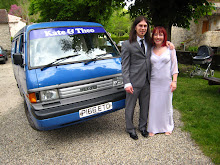When we first arrived in Spain last May, Miguel told us we'd be daft to pass up the opportunity to visit Segovia. While we were sitting in the kitchen of his house near Bilbao he enthusiastically recommended places in Spain to visit and further whetted our appetites by showing us photos he'd taken during his own forays in his homeland. Miguel told us as impressive as the architecture and historic remains are in other parts of the world, Spain can almost always match or better them. Including, he said, cathedrals and Roman ruins.
For a modest-sized place, Segovia seems to be trying to justify Miguel's Spanish pride all on its own. Its importance has waxed and waned over the centuries, but in the course of its history, it's been equipped with an imposing gothic cathedral, a fairytale castle (Walt Disney based his iconic turrets on the Alcazar) and an almost intact Roman aqueduct. Not to mention the various monastery, church and old synagogue buildings, whose towers and spires add their elegance to the Segovia's cobbled streets, colonnades and half-timbered houses.

Of the various monuments, I think Theo and I liked the aqueduct best. A simple, yet epic design, you often come across it unexpectedly by turning a corner in a random street. Or you cross and re-cross beneath it as it stretches between roadways and buildings, until it reaches its zenith in a kind of soaring, arched splendour over the Plaza de Azoguejo. It is 800 metres long in total, is 30 metres at its highest point and was built without mortar or cement. It doesn't carry water any more, but it really is a sight to behold and as Theo and Miguel both observed, it easily rivals Italy's own remnants of the Roman age.

The Alcazar is very pretty - especially when set against a glorious sunset or perfect blue sky (we were lucky enough to catch it in both settings), but it lacks the authenticity of the aqueduct, especially when you realise it was entirely reconstructed in the 19th century in an even more stylised version of the original. It's not surprising old Walt was so keen to adopt it for Disneyland.
Other than its splendid sights, Segovia also endeared itself to us by being generally cheap. Or should that be good value for money? Giving up on finding an eatery that opened on Wednesday nights and served some vegetarian food, we opted to fill ourselves up with beer and tapas. Which we did for less than 7 euros the lot. Bargain!




 The Alcazar is very pretty - especially when set against a glorious sunset or perfect blue sky (we were lucky enough to catch it in both settings), but it lacks the authenticity of the aqueduct, especially when you realise it was entirely reconstructed in the 19th century in an even more stylised version of the original. It's not surprising old Walt was so keen to adopt it for Disneyland.
The Alcazar is very pretty - especially when set against a glorious sunset or perfect blue sky (we were lucky enough to catch it in both settings), but it lacks the authenticity of the aqueduct, especially when you realise it was entirely reconstructed in the 19th century in an even more stylised version of the original. It's not surprising old Walt was so keen to adopt it for Disneyland.



 Christophe stacked the crates on his forklift, emptied them into a machine to separate the grapes from the stems and got the fermentation process under way. Naturally all this was done in a very French way - everyone watching, momentarily taking charge or giving advice. Vastly entertaining for us though. All the gloom and doom in the news about the financial markets seems a world away from this rural idyll of helpful neighbours, home brew and rustic feasts. A perfick birthday.
Christophe stacked the crates on his forklift, emptied them into a machine to separate the grapes from the stems and got the fermentation process under way. Naturally all this was done in a very French way - everyone watching, momentarily taking charge or giving advice. Vastly entertaining for us though. All the gloom and doom in the news about the financial markets seems a world away from this rural idyll of helpful neighbours, home brew and rustic feasts. A perfick birthday.


